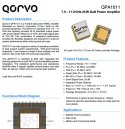SPY-4 is “ready”. It’s installed on the Ford carrier. It’s just that its main platform, the Zumwalt class was cancelled and funding was redirected to the AMDR project which became the SPY-6.
And the conversation back there was about SPY-1, its replacement SPY-6, how SPY-1 series (except E) did not use AESA and ...
The whole point of your exercise was to demonstrate China’s alleged technological advantage in naval radar technology. While China has made tremendous strides in the last 20 years, the evidence is simply not there yet that it is a world leader. The US has put several AESA radar designs to sea since the mid 2000s, therefore they’ve had the technological means to pull off a “Type 346A”, but for various reasons opted to wait for a GaN AESA instead for their Aegis ships.
... that the point is China was never that far behind even 20 years ago. My post was in response to another post claiming how far China's come in recent decades when it was far from an overnight thing. This was a step by step improvement over many, many decades. China was developing AESA radars with one program resulting in 346, over 20 years ago. It isn't my purpose to demonstrate China's alleged tech advantage ... I never said advantage. The exercise and posts were to show that this all didn't come from seemingly out of nowhere and in a short span of time. It took so much monumental national effort over such span of time to get here ... competitive and indeed world leading. You talked about SPY-4 cancelled with Zumwalt but put onto a post 2020 carrier. We were talking about 346. Not 346A not 346B where there are years to decades between the three. 346 and SPY-1. SPY-4/6 are indeed AESA. In my original post I said that SPY-1 series and Burke flights I and II do not even use AESA. That in itself isn't untrue but seems to have set you off a bit. It's also not untrue that during this era (well before SPY-4 and SPY-6) China had AESA search and fire control in 346 while the Americans had PESA SPY-1 series. That choice I didn't comment on. They have their choices. It doesn't mean and I didn't say they aren't capable of AESA. That's ridiculous. The Americans had AESA radars on the ground and in aircraft well before China had AESA in anything.
My point about China never having been that far behind in radars still stands. That was the entire purpose of the exercise. Here's the quote I replied to.

In light of this post screenshot is it not reasonable to explain that China's radar tech even 30 years ago was working on 346... which made use of AESA tech... 30 years ago when it started development, the radar reaching service in the early 2000s now more than 20 years ago. 346 coming out well before Sampson - the best the UK and France could develop much later than China... and honestly inferior in capability to even 346 (in capability not necessarily sophistication but then even that remains to be seen... if not then there's 346A). Japan uses SPY series as does Korea. Russia hasn't yet developed a 346 equivalent today. What's wrong with pointing out the simple fact that 346, a 30 year old Chinese program and 20+ year old radar uses AESA while SPY-1 series of that era did not? I didn't choose to go into listing the reasons why the Americans didn't use AESA until SPY-6... or if you insist, until SPY-4 in any major mainstay ship or classes.
One detail that’s not mentioned often is that SPY-1, unlike an AESA radar, can channel all its power through a single radar face, effectively quadrupling its power. This is what they’ve been doing for ABM defense. Perhaps they observed that a GaAs AESA would not be superior in ABM role going against that much emitted RF power?
This is interesting information and I appreciate it. It certainly explains their choices but it is sort of not part of that discussion about "China's radars being so behind 20 years ago"... as explained above.
Type 055 is not an electric ship. It has more installed total power than Zumwalt, but less electrical power. Another destroyer that has more electrical power is the British Type 45, yet another full electric ship.
I prefer to stick with what we know with a high degree of certainty. That is that there are 6 electrical generators onboard the Type 055, and based on vents that they are diesel engine based. We have no clue about their power output. They could be anywhere between 2MW to 6MW per unit, as Henri K explained 5 years ago. Again, because this is not an electric ship I lean towards the lower range. Even at the highest end of the spectrum that still puts it at less than half the electrical power of the Zumwalt.
Yeah 055 isn't yet IEP full electric ship. We speculate this is the direction PLAN wants to go obviously and if 055 isn't IEP, then they want to work towards that direction.
Even if we lean towards unreasonably low assumptions on output, 055's available power is significantly greater to other destroyers. Okay, installed power. This I'm not familiar with or knowledgeable on. What is the effective difference between that? Is it more to do with propulsion having a certain share and where that power can be directed? Or how it is stored and used? The effects of which mean full electric IEP ships have more power for electronics? Does 055 use a lot more installed power to compensate for not being IEP?

